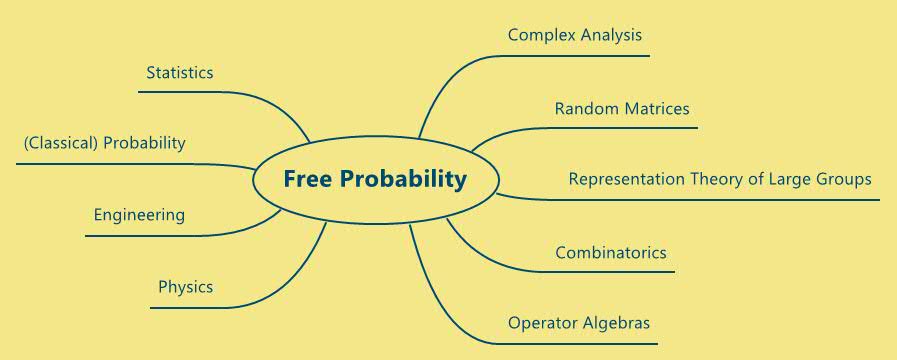What is Free Probability?

For a general introduction to free probability see also the survey article
or watch the videos
A motivating example
Consider the following three natural questions from the fields of operator algebras, random matrices, and combinatorics, respectively.
- What is the distribution of the real part of the one-sided shift with respect to the canonical vacuum expectation state?
- What is the asymptotic eigenvalue distribution of a Gaussian random matrix in the limit of large matrix size?
- In how many ways can one connect 2n points on a circle pairwisely by n non-intersecting chords?
Surprisingly, all three questions have essentially the same answer: both question 1 and 2 yield the semicircular distribution, and the answer to question 3 is given by the Catalan numbers which are actually the even moments of the semicircular distribution. This coincidence is not just superficial - a conceptual reason is given by Voiculescu's free probability theory and its basic concept of freeness.
Origins and aspects of free probability
Free probability theory originated from questions about the structure of von Neumann algebras related to free groups, namely those related to constructions around free products of groups. One of the big unsolved problems in operator algebra is the question, whether the free group factors are all isomorphic or not. Free probability theory is a very promising attempt to attack this problem.
But also, free probability theory has evolved into a field with links to many other quite unrelated fields: most notably random matrices, but also combinatorics, representation theory of large groups, mathematical physics, or as applied fields as financial correlations and wireless communications. Roland Speicher developed a combinatorial approach to free probability theory - which explains why the third of the above questions is related to the other two - and this has played a major role in many of those investigations.
Non-commutative distributions in free probability
Free probability theory deals with distributions of variables. Whereas in the above mentioned example of the semicircular distribution one has only one variable, the main interest is actually the multivariate situation, where one has several variables. Typically those variables do not commute, so one wants to understand non-commutative distributions. Such distributions may arise in the large N limit of random multi-matrix models, as the distribution of operators in operator algebras, or they might encode interesting combinatorial information. In each of those fields the understanding of properties of the non-commutative distribution is related to fundamental problems.
- In random matrix theory: to the existence and properties of the limit of multi-matrix models;
- In operator algebras: to one of the most famous open problems, namely the isomorphism problem for free group factors; and more generally, to invariants for von Neumann algebras;
- In combinatorics: to the counting of planar graphs or maps.
One should note that for one variable or, more general, for several commuting variables one has very powerful classical analytical tools (like Fourier transform) for dealing with those objects. In the non-commutative, however, all those classical tools break down and one is in need of a new kind of non-commutative analysis (aka free analysis). Such a theory is still in its infancy.
In the projects of the ERC Advanced Grant NCDFP, held by Roland Speicher between 2014 and 2019, the aim was to develop tools for dealing with such non-commutative distributions.
Links to web pages concerning free probability
Banff workshops:
- Banff Workshop on Free Probability Theory, 2004 (including Final Report)
- Banff Workshop on Free Probability, Extensions and Applications, 2008 (including Final Report)
- Banff Workshop on Analytic versus Combinatorial in Free Probability, 2016 (including Final Report)
Oberwolfach workshops:
- Oberwolfach Workshop on Free Probability Theory, 2005 (including Workshop Report)
- Oberwolfach Workshop on Free Probability Theory, 2015 (including Workshop Report)
- Oberwolfach Workshop on Free Probability Theory, 2018 (Workshop Report is here)
- Oberwolfach Workshop on Real Algebraic Geometry with a View Toward Hyperbolic Programming and Free Probability, 2020 (including Workshop Report)
Videos from the Focus Program on Noncommutative Distributions in Free Probability Theory, 2013 at the Fields Institute, Toronto, Canada (talks and expository lectures):
Some general links:
- Blog on Free Probability Theory
- Literature on free probability
- What is a free cumulant? (by Jonathan Novak and Piotr Sniady)
- Voiculescu receives NAS award in mathematics
- Conferences concerning free probability theory
- Survey articles by Roland Speicher
Wikipedia:
- Free probability on wikipedia (English)
- Freie Wahrscheinlichkeitstheorie auf Wikipedia (German)
Postal address
Saarland University
Department of Mathematics
Postfach 15 11 50
66041 Saarbrücken
Germany
Visitors
Saarland University
Campus building E 2 4
66123 Saarbrücken
Germany

